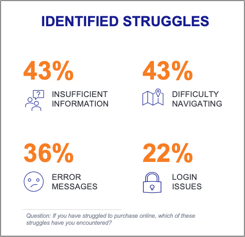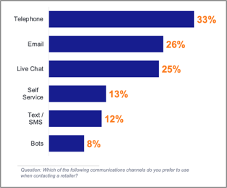Despite the best effort retailers have made to improve the online experience, consumers struggle to complete basic tasks when shopping online. A recent Consumer Retail survey found that 83% of shoppers expect to easily find what they’re looking for but 40% have recently struggled to complete a transaction online. 62% of those surveyed said when they’ve struggled, they have abandoned the shopping experience entirely. Only 26% reach out for help. No wonder Forrester research found that brands can lose up to $18B in revenue per year due to shopping cart abandonment.
Online shoppers face a myriad of basic obstacles that can easily be avoided. When asked about what consumers struggle with when retail shopping, the most frequently encountered struggles included insufficient information (43%), difficulty navigating (43%), error messages (36%) and login issues.

The survey found that consumers have clear interaction preferences. Retailers that look to keep customers in the digital channel and avoid channel shifting should focus on optimizing email and live chat.

The good news is there are plenty of ways to fight back against customer frustration, provided you’re willing to examine your customer’s journey and understand the best practices for minimizing friction.
It’s time to recover some of the $18B in yearly sales revenue lost due to shopping cart abandonment. Here are five strategies proven to eliminate customer struggle:
1. Focus on the channels your customers prefer.
Email and live chat continue to be the most preferred digital channels. Optimize these interaction channels by being proactive when you detect customer struggle and offering live chat or email assistance based on urgency and need. Before you invest in technology to support your customers, make sure they will use it.
2. Avoid struggle by anticipating it.
Online customers tell you where they are, and often what they need, by their behavior. Guide consumers with useful information before they have to ask for it or even realize they have a question.
3. Communicate proactively and clearly.
While the information consumers need may be somewhere on your site, it can be difficult for consumers to find when the need it – especially on mobile devices. Present snippets of contextual and relevant information throughout the journey. A nudge may be all that’s needed to keep the customer engaged in the purchase path.
4. Guide consumers to complete basic tasks online.
Digital guidance provides the needed information at the point of struggle without requiring the involvement of an agent. Examples include: 1) use guidance to instruct customers how to enter a coupon or gift card before they receive an error, or 2) guide customers to reset their password to avoid lockout and an unnecessary contact.
5. Deflect repeat contacts.
Once you’ve earned a customer, don’t make them contact you for basic information. Guide them to the “Where Is My Order?” page or offer up the return policy before they contact the business. Save live agents for valuable interactions—and more importantly, save your customers valuable time.
Overall, the most optimal solutions for eCommerce frustration rely on good guidance at every step of the journey. In today’s post COVID-19 world, consumers are shopping online more than ever before. Minimize their potential frustration and make sure your shoppers aren’t expected to navigate through confusing moments alone.
Meet their expectations while improving your customers’ online experience—without compromising efficiency.



